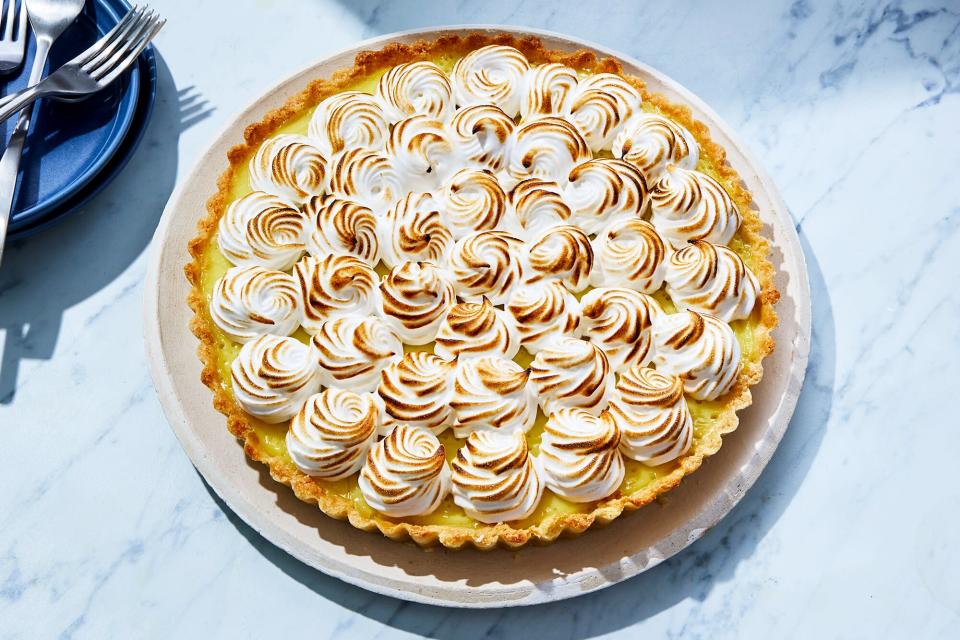
Photo by Jennifer Causey / Prop Styling by Julia Bayless / Food Styling by Ruth Blackburn
Every year, the Food & Wine Classic in Aspen provides an opportunity to learn from some of the most innovative chefs in the industry. The weekend schedule is packed with live cooking demonstrations where presenters show you how to make all kinds of delicious recipes — from Stephanie Izard’s rich Buttered Rum to Maneet Chauhan’s bright Strawberry-Rhubarb Chaat — and field questions from the audience during Q&A portions, too. As the chefs cook, they also typically share helpful tips here and there, like how to make sure your poached eggs come out perfectly; why you should temper chocolate in the microwave; and when to use dark versus light soy sauce.
Now that the 2022 Classic is over, we went back and compiled a list of all the helpful tips and tricks we picked up over the weekend so you can use them at home — and turn out some seriously next-level meals. Wondering how to poach lobster tails without overcooking them? Chef Erick Williams has you covered. Making meringue for the first time? Pastry chef Claudia Fleming has advice you don’t want to miss. Read on for all 38 tips, and keep an eye out for when we release details about next year’s Classic.
Cook Lobster Tails Off the Heat

Photo by Antonis Achilleos / Prop Styling by Christina Dale / Food Styling by Emily Nabors Hall
Chef Erick Williams made cornbread and then used it as the base for two more recipes during his cooking demo. One of his dishes was Lobster Tournedos with Cornbread. His preferred method for cooking a lobster tail is to let it sit off-heat in very hot water. Start by bringing water to a simmer on the stovetop and placing the lobster tail in a heat-safe bowl. Then, pour the hot water on top of the lobster, cover the bowl, and let it sit for four and a half minutes. After that, remove the shell and sauté the lobster meat in butter, which will finish it without overcooking the meat.
How to Avoid Burned or Eggy French Toast
When making French toast batter, make sure you use enough milk — Williams says it loosens the eggs, ensures a moist product, and also adds a little bit of sweetness.
When Cooking Fibrous Vegetables, Cut Them on the Bias
During his cooking demo, Food & Wine Culinary Director-at-Large Justin Chapple explained that you should cut fibrous vegetables (such as celery) on the bias; it exposes more of their fibers and thus helps them cook more evenly and quickly. This will also allow you to serve the vegetables in larger pieces while retaining a tender texture.
Need to Hull Strawberries? Use a Straw
Chapple also shared an easy trick for hulling strawberries. Just poke a straw through the bottom of the strawberry and push up until the leafy top pops out.
Let Your Rice Cook in Peace
Top Chef season 19 winner chef Buddha Lo says that when you’re cooking rice, you want to leave it alone. Lifting the lid to peek very occasionally is okay, but resist the temptation to stir. You don’t want to disrupt the starches in the rice.
Freeze Your Biscuits Before Baking
Chef Brooke Williamson shared brunch tips as she made this recipe for Turmeric-Poached Eggs with Chive Biscuits and Lobster Gravy. She has you freeze the biscuits for 15 minutes (until they’re firm but not fully frozen) before baking. Williamson says baking biscuits from frozen keeps them tender on the inside.
Cold Eggs = Better Poached Eggs

Photo by Jennifer Causey / Prop Styling by Julia Bayless / Food Styling by Ruth Blackburn
As for the poached eggs, Williamson recommends starting with cold eggs — she finds that the whites coagulate faster when cold. Adding vinegar to the water in the pot will help the coagulation along, too. (She uses apple cider vinegar.)
Season Your Poaching Water
Another tip from Williamson: Just as you season pasta water, season your egg-poaching water, too. Seasoning ingredients throughout the cooking process gives the dish deeper flavor.
Don’t Crack Your Eggs Right Into the Pot
Williamson offered one more tip for poaching eggs: Instead of cracking the eggs directly into the pot, crack them first into a small bowl or ramekin. This not only prevents pieces of shell from going into the pot, but also allows you to gently lower the eggs into the water and keep them intact.
Keep Your Cucumbers Crunchy
Recipe developer and blogger Tiffany Chen, also known as TiffyCooks, says that when you’re making cucumber salad, season the cucumbers with a mixture of sugar and salt first to coax out water. This will help the cucumbers stay crunchy.
Layer Your Soy Sauces
When cooking with soy sauce, Chen also notes to use light soy sauce for flavor, and dark soy sauce for richness and color.
Be Careful With White Pepper
There’s one spice Chen says you have to be careful with. When you add white pepper to a pan, stand back — the spice is so fine that it can get in your eyes and throat.
Stabilize Your Simple Syrup
Simple syrup is commonly used to sweeten drinks. Chef Michelle Bernstein suggests adding a little corn syrup to the mix, which will help stabilize it.
Shrimp Is an Easy Choice for Ceviche
If you want ceviche but don’t have access to a lot of fresh seafood, Bernstein says shrimp is your best bet. If you can’t find shrimp, make ceviche with vegetables. Whatever you do, make sure you finish it with a drizzle of good quality olive oil.
Score a Perfect Sear

Photo by Jennifer Causey / Prop Styling by Julia Bayless / Food Styling by Ruth Blackburn
Chef Tyler Florence explained that when you’re searing steak, two things are key: making sure the surface of the steak is “as dry as possible,” and that the pan is hot as possible so the meat develops a nice crust.
Keep Béarnaise Sauce Warm
Speaking of steak, if you’re serving it with béarnaise sauce like Florence does in this recipe, make sure you set it aside in a warm place until you’re ready to use it. The key word here is warm — if it gets too cool, the butter will harden, and if it gets too hot, you’ll end up with a broken sauce.
For the Freshest Parm, Buy Your Own Wheel
Instead of buying a wedge of Parmigiano-Reggiano cheese from the grocery store, buy a wheel if you can. Florence says wedges lose aroma and flavor due to air exposure.
Finish Your Dish with Citrus Juice
Chef Claudette Zepeda recommends finishing a dish with a squeeze of fresh lemon or lime juice for a burst of bright acidity.
Save Extra Tempura Batter
Chef Stephanie Izard likes to put extra tempura batter into a squeeze bottle, drizzle it into hot oil, and fry it up into tiny, crunchy pieces. She then tosses the tempura bits with some powdered sugar as a topping for ice cream.
How to Know if Your Tempura Is Done

Photo by Jennifer Causey / Prop Styling by Julia Bayless / Food Styling by Ruth Blackburn
Chef Shota Nakajima offers two ways to check if your tempura is ready when you’re frying. First, look at the sizzle of the bubbles around the tempura — if they’re big, he says that there’s still a lot of moisture in the batter. He also likes to hold the ingredient with chopsticks and feel the vibrations as it fries. If the vibrations are big, that also signifies there’s still a lot of moisture in the batter and the item isn’t cooked through.
The Secret to Tempura that Isn’t Oily
In order to avoid oily tempura, Nakajima says to pull each piece out of the oil slowly at an angle, which reduces the amount that will cling to the ingredient.
Filling a Piping Bag? A Deli Container Can Help
When you fill a piping bag with frosting or meringue, pastry chef Claudia Fleming recommends standing the bag tip-down in a cylindrical container (like a quart-sized deli container or a mason jar). This way, you can keep your hands free and scoop the frosting/ganache/etc. into the bag more easily.
Need to Make a Double Boiler? Use a Stainless Steel Bowl
If you’re working with a makeshift double boiler, Fleming says to use a stainless steel bowl, not a glass one. The former not only conducts heat better, but it’s lighter, too.
Make the Perfect Meringue

Photo by Antonis Achilleos / Prop Styling by Christina Dale / Food Styling by Emily Nabors Hall
Fleming says that when you’re making a meringue, make sure that all of the sugar is moistened. Any dry pockets will crystalize and you’ll have to start over.
Use the Rule of Three (or Five, or Seven)
Pastry chef Paola Velez stands by the rule of three when plating and decorating, and recommends sticking to an odd number for the best visual effect. (Nine is the max, in her opinion.)
Temper Chocolate in the Microwave
Tempering chocolate can be intimidating, but Velez demonstrated that your microwave can be your best friend in this situation. A combination of heating the chocolate in brief intervals in the microwave, stirring, and relying on residual heat will get you chocolate that’s shiny and snaps beautifully.
Your Immersion Blender Is Good for More Than Velvety Soups
Instead of whipping cream with a mixer — or by hand with a whisk, if you’re feeling particularly ambitious — Velez shows that you can easily pull it off with an immersion blender. (Just keep the blender submerged while you whip.)
Homemade Chocolate Shell Is Only Two Ingredients Away
If you love crispy, crunchy chocolate shell on ice cream (or other frozen desserts), making a homemade version is a snap. Just melt chocolate and coconut oil together in the microwave in brief increments, stirring in between, until you have a smooth mixture. Velez uses the trick in her Banana Pudding Paletas recipe, which she demonstrated for the crowd.
You Don’t Need a Lazy Susan to Decorate a Cake
Velez shows that it’s also easy to place the cake on a cake stand and rotate the stand as you go.
Mendiants Make Easy (and Delicious) Gifts

Photo by Jennifer Causey / Food Styling by Torie Cox / Prop Styling by Lydia Pursell
In her cooking demonstration, Velez also made these beautiful Tropical Mendiants. She says you can use whatever you have in your pantry to top the tempered chocolate disks — chopped dried mango and apricot, toasted coconut, pepitas, almonds, and more. Once the mendiants are done, add them to a bag and they’re ready for gifting.
Treat Yourself to Crispy Duck
Love duck? Follow chef Shirley Chung’s cue and score the skin (with shallow cuts, without touching the muscle) so the fat can render easily and the exterior gets nice and crispy.
No Wok? A Cast-Iron Skillet Is the Next Best Thing
Chung notes that cast-iron skillets can achieve similar results to woks because they have high heat retention.
You Don’t Always Have to Use a Chef’s Knife
Chung says you can use what you’re comfortable with — for example, she sometimes uses kitchen scissors when working with fish (so does Bernstein).
Texture, Texture, Texture
Chung says the key to making a home-cooked meal look like fine dining is creating textures when plating. An example would be splitting a sugar snap pea lengthwise down the middle to expose the inside.
Add Garlic Last
Chef Tiffany Derry explains that adding garlic to the pan last will help ensure it toasts instead of burning.
When Cooking Protein, Make Sure You Have Enough Heat
Chef Andrew Zimmern recommends letting protein reach room temperature before cooking. First, heat up the fat and aromatics in the pan. Once you’re ready to add the protein, turn up the heat a little. Adding new ingredients to the pan lowers the temperature, and you want the protein to start cooking right away.
Flour Your Meat Well
When flouring meat for stews, Zimmern says to use one cup of flour per pound of meat. And of course, season the mixture first!
Unless Instructed to, Don’t Wipe Fond from a Pan
When you’re removing fat from a pan, Zimmern recommends two methods. The first is using a slotted spoon to move ingredients to the side of the pan so you can tilt it and pour the fat off. The second is to blot the pan with a paper towel. Don’t wipe the pan clean unless the recipe instructs you to — otherwise, you’ll lose all of the delicious flavor from the fond (aka browned bits) on the bottom.






